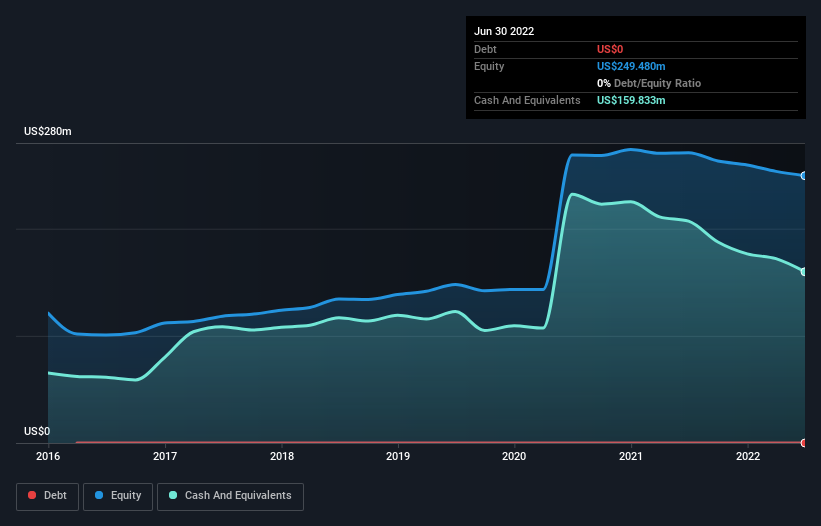- United States
- /
- Medical Equipment
- /
- NasdaqGS:CSII
We're Hopeful That Cardiovascular Systems (NASDAQ:CSII) Will Use Its Cash Wisely
Even when a business is losing money, it's possible for shareholders to make money if they buy a good business at the right price. For example, although software-as-a-service business Salesforce.com lost money for years while it grew recurring revenue, if you held shares since 2005, you'd have done very well indeed. But the harsh reality is that very many loss making companies burn through all their cash and go bankrupt.
So should Cardiovascular Systems (NASDAQ:CSII) shareholders be worried about its cash burn? In this article, we define cash burn as its annual (negative) free cash flow, which is the amount of money a company spends each year to fund its growth. The first step is to compare its cash burn with its cash reserves, to give us its 'cash runway'.
Check out the opportunities and risks within the US Medical Equipment industry.
Does Cardiovascular Systems Have A Long Cash Runway?
A cash runway is defined as the length of time it would take a company to run out of money if it kept spending at its current rate of cash burn. When Cardiovascular Systems last reported its balance sheet in June 2022, it had zero debt and cash worth US$160m. Looking at the last year, the company burnt through US$28m. That means it had a cash runway of about 5.6 years as of June 2022. While this is only one measure of its cash burn situation, it certainly gives us the impression that holders have nothing to worry about. Depicted below, you can see how its cash holdings have changed over time.

How Well Is Cardiovascular Systems Growing?
It was quite stunning to see that Cardiovascular Systems increased its cash burn by 489% over the last year. While that's concerning on it's own, the fact that operating revenue was actually down 8.8% over the same period makes us positively tremulous. Considering these two factors together makes us nervous about the direction the company seems to be heading. While the past is always worth studying, it is the future that matters most of all. For that reason, it makes a lot of sense to take a look at our analyst forecasts for the company.
Can Cardiovascular Systems Raise More Cash Easily?
While Cardiovascular Systems seems to be in a fairly good position, it's still worth considering how easily it could raise more cash, even just to fuel faster growth. Generally speaking, a listed business can raise new cash through issuing shares or taking on debt. Commonly, a business will sell new shares in itself to raise cash and drive growth. By comparing a company's annual cash burn to its total market capitalisation, we can estimate roughly how many shares it would have to issue in order to run the company for another year (at the same burn rate).
Cardiovascular Systems' cash burn of US$28m is about 5.3% of its US$541m market capitalisation. That's a low proportion, so we figure the company would be able to raise more cash to fund growth, with a little dilution, or even to simply borrow some money.
How Risky Is Cardiovascular Systems' Cash Burn Situation?
Even though its increasing cash burn makes us a little nervous, we are compelled to mention that we thought Cardiovascular Systems' cash runway was relatively promising. While we're the kind of investors who are always a bit concerned about the risks involved with cash burning companies, the metrics we have discussed in this article leave us relatively comfortable about Cardiovascular Systems' situation. Taking an in-depth view of risks, we've identified 2 warning signs for Cardiovascular Systems that you should be aware of before investing.
Of course Cardiovascular Systems may not be the best stock to buy. So you may wish to see this free collection of companies boasting high return on equity, or this list of stocks that insiders are buying.
New: AI Stock Screener & Alerts
Our new AI Stock Screener scans the market every day to uncover opportunities.
• Dividend Powerhouses (3%+ Yield)
• Undervalued Small Caps with Insider Buying
• High growth Tech and AI Companies
Or build your own from over 50 metrics.
Have feedback on this article? Concerned about the content? Get in touch with us directly. Alternatively, email editorial-team (at) simplywallst.com.
This article by Simply Wall St is general in nature. We provide commentary based on historical data and analyst forecasts only using an unbiased methodology and our articles are not intended to be financial advice. It does not constitute a recommendation to buy or sell any stock, and does not take account of your objectives, or your financial situation. We aim to bring you long-term focused analysis driven by fundamental data. Note that our analysis may not factor in the latest price-sensitive company announcements or qualitative material. Simply Wall St has no position in any stocks mentioned.
About NasdaqGS:CSII
Cardiovascular Systems
Cardiovascular Systems, Inc., a medical technology company, develops and commercializes solutions to treat peripheral and coronary artery diseases in the United States and internationally.
Flawless balance sheet and overvalued.
Similar Companies
Market Insights
Community Narratives



